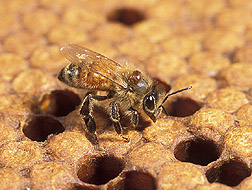| 
Varroa mite on an adult worker honey bee's thorax.
Click the image for more information about it.
Read the
magazine
story to find out more.
|
Fungus
Provides Varroa Mite Relief for Bees
By Alfredo
Flores
October 14, 2004 A natural fungus could be a
nonchemical alternative for beekeepers looking for ways to control the
parasitic varroa mite, according to Agricultural Research Service scientists in
Weslaco, Texas.
For several years, scientists in the ARS
Beneficial Insects Research Unit at
Weslaco have been looking for a natural organism that's harmless to bees but
kills the mites.
New, nonchemical controls are needed because the mite has developed
resistance to the only approved chemicals--fluvalinate and coumaphos--now used
against varroa. So the researchers looked at various organisms, tried different
dosages and application methods, and conducted toxicity tests. Finally, they
selected strains of the fungus Metarhizium anisopliae that proved highly
pathogenic to the mites.
This potent fungus, which also kills termites, doesn't harm bees or affect
queen reproduction. To test the fungus, the scientists coated plastic strips
with dry fungal spores and placed them inside the hives. Since bees naturally
attack anything entering their hives, they tried to chew the strips, thereby
spreading the spores to the whole colony.
In field trials, once the strips treated with M. anisopliae were
inside the hives, several bees quickly made contact with the spores. Within 5
to10 minutes, all the bees in the hive were exposed to the fungus, and most of
the mites on the bees died within three to five days. The fungus provided
excellent control of varroa without impeding colony development or population
size. Tests showed that Metarhizium was as effective as fluvalinate,
even 42 days after application.
The scientific team is now fine-tuning the strategy for transfer to
producers.
Read
more about this research in the October 2004 issue of Agricultural
Research magazine.
ARS is the U.S. Department of
Agriculture's chief scientific research agency.
|